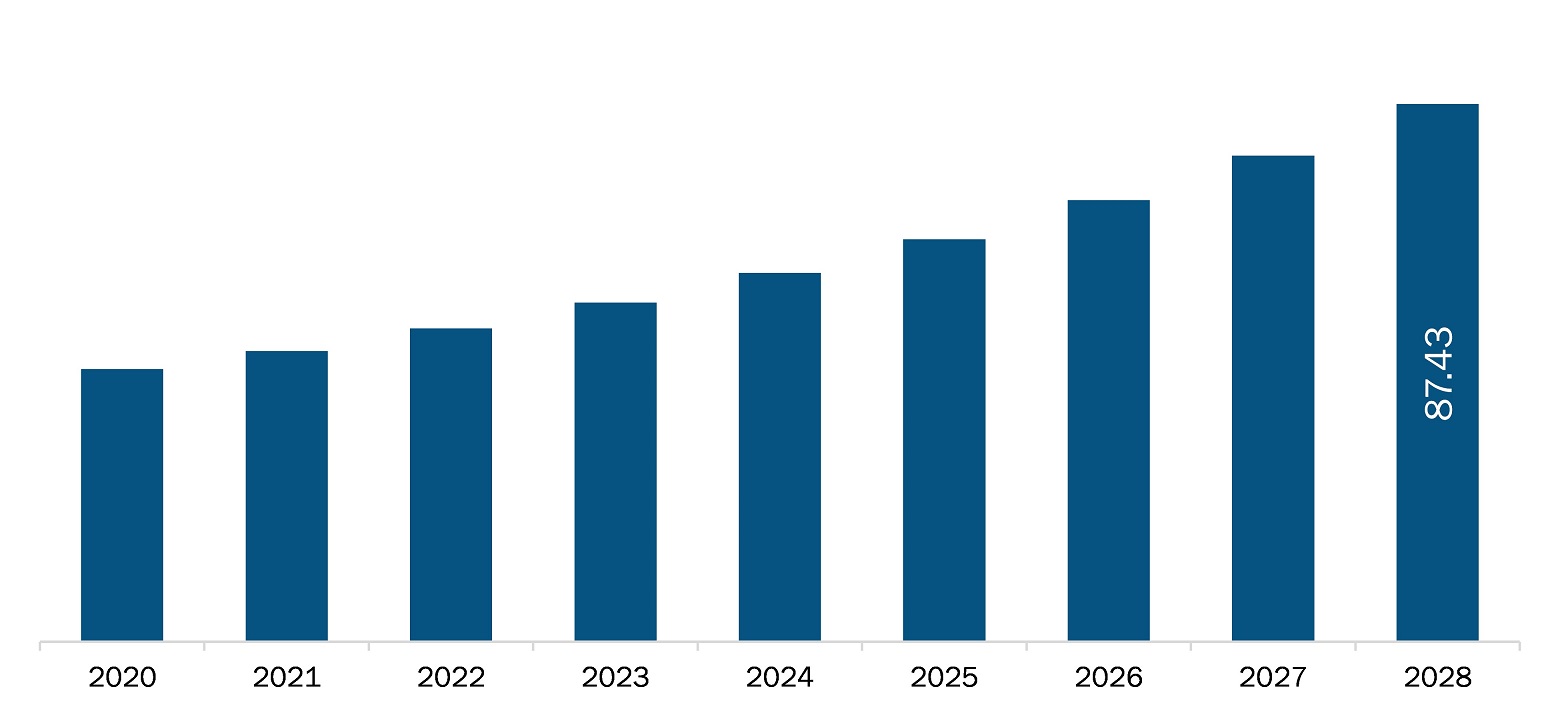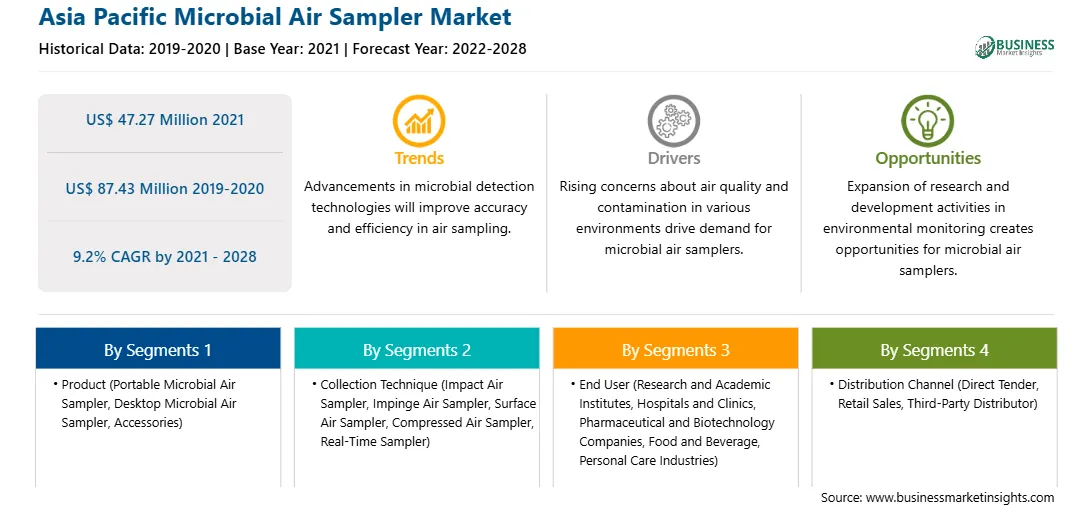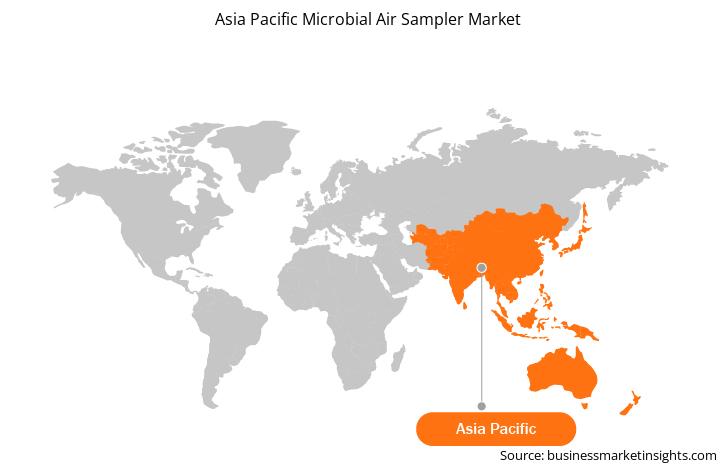A microbial air sampler is a sampling device that can be used to examine microbiological particles in the air or in a controlled environment. This microbial air sampler works by pushing air into or onto a collection medium for a predetermined amount of time. After incubating the acquired culture, the presence of the microbe in the air is evaluated subjectively and quantitatively. It can be used for indoor microbiological contamination examinations in all rooms, in clean rooms in the pharmaceutical business, and in hygienically sensitive production facilities and equipment in the food industry.

Strategic insights for the Asia Pacific Microbial Air Sampler provides data-driven analysis of the industry landscape, including current trends, key players, and regional nuances. These insights offer actionable recommendations, enabling readers to differentiate themselves from competitors by identifying untapped segments or developing unique value propositions. Leveraging data analytics, these insights help industry players anticipate the market shifts, whether investors, manufacturers, or other stakeholders. A future-oriented perspective is essential, helping stakeholders anticipate market shifts and position themselves for long-term success in this dynamic region. Ultimately, effective strategic insights empower readers to make informed decisions that drive profitability and achieve their business objectives within the market.

| Report Attribute | Details |
|---|---|
| Market size in 2021 | US$ 47.27 Million |
| Market Size by 2028 | US$ 87.43 Million |
| CAGR (2021 - 2028) | 9.2% |
| Historical Data | 2019-2020 |
| Forecast period | 2022-2028 |
| Segments Covered |
By Product
|
| Regions and Countries Covered | Asia-Pacific
|
| Market leaders and key company profiles |
|
The geographic scope of the Asia Pacific Microbial Air Sampler refers to the specific areas in which a business operates and competes. Understanding local distinctions, such as diverse consumer preferences (e.g., demand for specific plug types or battery backup durations), varying economic conditions, and regulatory environments, is crucial for tailoring strategies to specific markets. Businesses can expand their reach by identifying underserved areas or adapting their offerings to meet local demands. A clear market focus allows for more effective resource allocation, targeted marketing campaigns, and better positioning against local competitors, ultimately driving growth in those targeted areas.

The Asia Pacific microbial air sampler market is expected to reach US$ 87.43 million by 2028 from US$ 47.27 million in 2021; it is estimated to register a CAGR of 9.2% from 2021 to 2028. The growth of the market is attributed to key driving factors such as growing usage of microbial air samplers in combating the COVID-19 situation and increasing cases of food contamination by microbes. However, the high capital investment for setting up an advanced lab is restraining the market growth.
Industrialization has resulted in environmental damage. Economic activities have the potential to improve or degrade environmental quality, which can help or hinder economic operations. Ambient air pollution accounts for an estimated 4.2 million deaths per year due to stroke, heart disease, lung cancer, and acute and chronic respiratory disease. Approximately 91% of the world's population lives in areas where air quality is below the acceptable standards set by the World Health Organization (WHO). As a result, numerous environmental protection acts have been enacted, providing a significant opportunity for the environmental testing market. In the next five years, various changes and new environmental safety standards are projected to be implemented, mostly in developing economies owing to increased pollution and environmental contamination. The constant development of innovative testing methods for contaminant samples such as pesticide residues, heavy metals, and organic compounds is likely to contribute significantly to the market's growth.
Countries in Asia Pacific are facing challenges due to increasing incidences of COVID-19 in the second wave of the pandemic. The COVID-19 pandemic is projected to generate highly lucrative opportunities for microbial air sampler in the region, as the novel COVID-19 virus is found to be air borne. The pandemic provides impetus to the market growth, with clinics, hospitals, and CROs pushing for greater adoption. The current outbreak is likely to result in several permanent changes in how the healthcare sector is organized. Moreover, market players are now investing their efforts in offering better service, particularly in the detection of virus. For instance, in April 2020, the Bertin Technologies developed the air sampler Coriolis µ (Micro) to collect Coronavirus (SARS-CoV-2) and help combat its spread in Asia and Europe. The Bertin Technologies Coriolis air samplers have been extensively used by the Shenzhen and Guangzhou Centers for Disease Control and Prevention (CDC) as well as the South China Institute of Environmental Sciences to collect coronavirus SARS-CoV-2 responsible for COVID-19 infections and clearly evaluate the risk of aerosol contamination in critical areas. Thus, owing to the above-mentioned factors, the spread of COVID-19 has had a positive impact on the Asia Pacific microbial air sampler market.
The Asia Pacific microbial air sampler market, by product, is segmented into portable microbial air sampler, desktop microbial air sampler, and accessories. The portable microbial air sampler segment held the largest share of the market in 2021 and is anticipated to register the highest CAGR during the forecast period.
The Asia Pacific microbial air sampler market, based on collection technique, is segmented into impact air sampler, impinge air sampler, surface air sampler, compressed air sampler, real-time samplers, and others. In 2021, the impact air sampler segment is likely to hold the largest share of the market and is expected to grow at the fastest rate in the coming years.
The Asia Pacific microbial air sampler market, by end user, is segmented into research and academic institutes, hospitals and clinics, pharmaceutical and biotechnology companies, food and beverage, personal care industries, and others. The research and academic institutes segment is likely to hold the largest share of the market in 2021 and is anticipated to register the highest CAGR during the forecast period.
The Asia Pacific microbial air sampler market, by distribution channel, is segmented into direct tender, retail sales, third-party distributor, and others. The direct tender segment is likely to hold the largest share of the market in 2021 and is anticipated to register the highest CAGR during the forecast period.
A few of the primary and secondary sources referred to while preparing associated with the report on the Asia Pacific microbial air sampler market are the India Brand Equity Foundation (IBEF), National Institute for Occupational Safety and Health (NIOSH), and World Health Organization (WHO).
The Asia Pacific Microbial Air Sampler Market is valued at US$ 47.27 Million in 2021, it is projected to reach US$ 87.43 Million by 2028.
As per our report Asia Pacific Microbial Air Sampler Market, the market size is valued at US$ 47.27 Million in 2021, projecting it to reach US$ 87.43 Million by 2028. This translates to a CAGR of approximately 9.2% during the forecast period.
The Asia Pacific Microbial Air Sampler Market report typically cover these key segments-
The historic period, base year, and forecast period can vary slightly depending on the specific market research report. However, for the Asia Pacific Microbial Air Sampler Market report:
The Asia Pacific Microbial Air Sampler Market is populated by several key players, each contributing to its growth and innovation. Some of the major players include:
The Asia Pacific Microbial Air Sampler Market report is valuable for diverse stakeholders, including:
Essentially, anyone involved in or considering involvement in the Asia Pacific Microbial Air Sampler Market value chain can benefit from the information contained in a comprehensive market report.